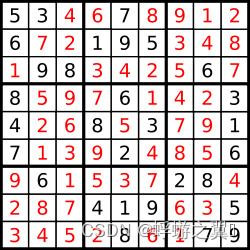Description
Write a program to solve a Sudoku puzzle by filling the empty cells.
A sudoku solution must satisfy all of the following rules:
Each of the digits 1-9 must occur exactly once in each row.
Each of the digits 1-9 must occur exactly once in each column.
Each of the digits 1-9 must occur exactly once in each of the 9 3x3 sub-boxes of the grid.
The ‘.’ character indicates empty cells.
Example

Input: board = [[“5”,“3”,“.”,“.”,“7”,“.”,“.”,“.”,“.”],[“6”,“.”,“.”,“1”,“9”,“5”,“.”,“.”,“.”],[“.”,“9”,“8”,“.”,“.”,“.”,“.”,“6”,“.”],[“8”,“.”,“.”,“.”,“6”,“.”,“.”,“.”,“3”],[“4”,“.”,“.”,“8”,“.”,“3”,“.”,“.”,“1”],[“7”,“.”,“.”,“.”,“2”,“.”,“.”,“.”,“6”],[“.”,“6”,“.”,“.”,“.”,“.”,“2”,“8”,“.”],[“.”,“.”,“.”,“4”,“1”,“9”,“.”,“.”,“5”],[“.”,“.”,“.”,“.”,“8”,“.”,“.”,“7”,“9”]]
Output: [[“5”,“3”,“4”,“6”,“7”,“8”,“9”,“1”,“2”],[“6”,“7”,“2”,“1”,“9”,“5”,“3”,“4”,“8”],[“1”,“9”,“8”,“3”,“4”,“2”,“5”,“6”,“7”],[“8”,“5”,“9”,“7”,“6”,“1”,“4”,“2”,“3”],[“4”,“2”,“6”,“8”,“5”,“3”,“7”,“9”,“1”],[“7”,“1”,“3”,“9”,“2”,“4”,“8”,“5”,“6”],[“9”,“6”,“1”,“5”,“3”,“7”,“2”,“8”,“4”],[“2”,“8”,“7”,“4”,“1”,“9”,“6”,“3”,“5”],[“3”,“4”,“5”,“2”,“8”,“6”,“1”,“7”,“9”]]
Explanation: The input board is shown above and the only valid solution is shown below:

Constraints
board.length == 9
board[i].length == 9
board[i][j] is a digit or ‘.’.
It is guaranteed that the input board has only one solution.
code
class Solution {
public:
void solveSudoku(vector<vector<char>>& board) {
Backtracking(0,0, board);
}
bool Backtracking(int row, int col,vector<vector<char>>& board)
{
//cout<<row<<" , "<<col<<endl;
if(row == 9)
{
return true;
}
if(col == 9)
{
return Backtracking(row+1, 0,board);
}
if(board[row][col]=='.')
{
for(int num=1; num<10;num++)
{
if(positionValid(row,col,num,board))
{
board[row][col]=num+'0';
if(Backtracking(row, col+1,board))
{
cout<<num;
return true;
}
else
board[row][col]='.';
}
}
return false;
}
else
return Backtracking(row,col+1,board);
}
bool positionValid(int row, int col, int value,vector<vector<char>>& board)
{
char v = value + '0';
auto rowIter = board[row].begin();
while(rowIter != board[row].end())
{
if(v == *rowIter)
{
return false;
}
rowIter++;
}
auto boardIter = board.begin();
while(boardIter !=board.end())
{
char colValue= (*boardIter)[col];
if(v == colValue)
{
return false;
}
boardIter++;
}
int subRow = int(row/3)*3;
int subCol = int(col/3)*3;
for(int i =subRow; i<subRow+3;i++)
{
for(int j= subCol;j<subCol+3;j++)
{
char subValue= board[i][j];
if(v == subValue)
{
return false;
}
}
}
return true;
}
};
Oral process of solving problems
I will use backtracking algorithms to solve the Sudoku problem. In each Recursive loop, I want to fill those cells by making choices. I think about this compartmentalizing into subproblems. firstly, I focus on a row which means that I solve it one column by one column. when I finish one row, then move to the next row. after I finish all rows, the problem will be solved. So I define my function like this:
bool Backtracking(int row, int col,vector<vector<char>>& board)
{
if(row == 9)
{// finshing all row means finish problem
return true;
}
if(col == 9) // out of column means we can change row
{
return Backtracking(row+1, 0,board);
}
...
// next column
if(Backtracking(row, col+1,board))
{
}
...
}
for each cell, I can place numbers 1 through 9 in the cell if it’s empty. then, I need to express my constraints. the thing is when we place an item, I could validate the whole Sudoku board. considered a possible number, I have to check if it is a unique number in a row, in a column, as well as in a subgrid. I write a function named “positionValid”. if that was a valid placement, I recurse on it. I will put the number over here, and go to the next column for this row, or begin of the next row.
bool positionValid(int row, int col, int value,vector<vector<char>>& board)
{
char v = value + '0';
auto rowIter = board[row].begin();
while(rowIter != board[row].end())
{
if(v == *rowIter)
{
return false;
}
rowIter++;
}
auto boardIter = board.begin();
while(boardIter !=board.end())
{
char colValue= (*boardIter)[col];
if(v == colValue)
{
return false;
}
boardIter++;
}
int subRow = int(row/3)*3;
int subCol = int(col/3)*3;
for(int i =subRow; i<subRow+3;i++)
{
for(int j= subCol;j<subCol+3;j++)
{
char subValue= board[i][j];
if(v == subValue)
{
return false;
}
}
}
return true;
}
for each empty cell, I will try all possible numbers from 1 to 9. for each possible number, I will check if the position is valid. if ok, I will put the number and go to the next empty cell. if not, I will put the cell empty and try another number. if all number is wrong, it means that I have to Backtrack the previous decision and modify the previous cell. So I return false.
if(board[row][col]=='.')
{
for(int num=1; num<10;num++)
{
if(positionValid(row,col,num,board))
{
board[row][col]=num+'0';
if(Backtracking(row, col+1,board))
{
cout<<num;
return true;
}
else
board[row][col]='.';
}
}
return false;
}
else
return Backtracking(row,col+1,board);
words
link
leetcode 37. Sudoku Solver
mit : Puzzle 8: You Won’t Want to Play Sudoku Again
Sudoku Solver
https://en.wikipedia.org/wiki/Mathematics_of_Sudoku
























 7638
7638

 被折叠的 条评论
为什么被折叠?
被折叠的 条评论
为什么被折叠?








